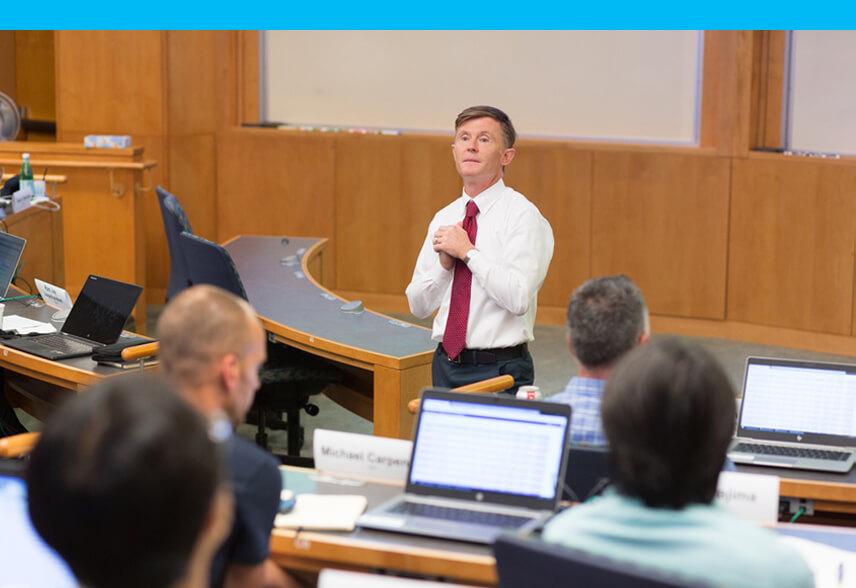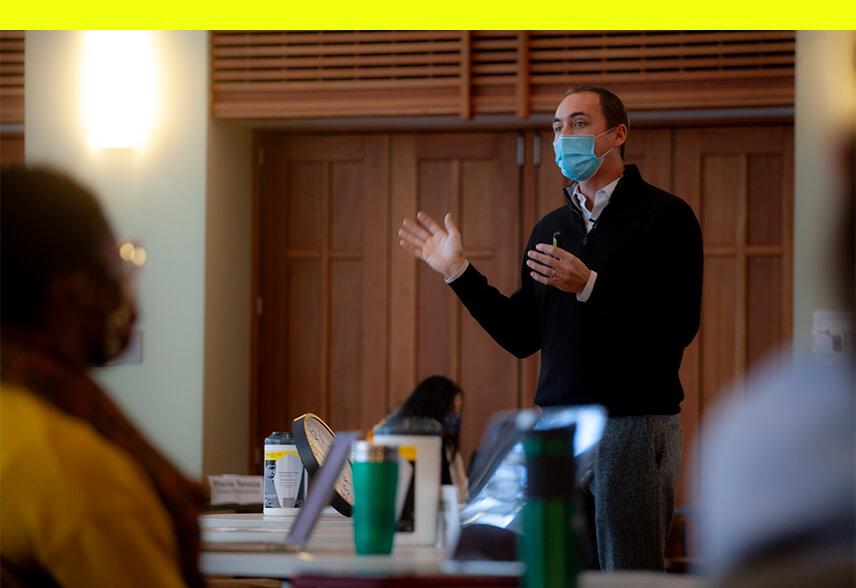Where Work Goes from Here: Tuck Faculty Insights
What will work look like when employees return to work? Tuck faculty offer their predictions on the new normal.

As the business world grapples with the challenges of the pandemic, Tuck faculty members are studying its immediate and long-term effects from a variety of perspectives. Their pandemic-related research topics include international trade, housing, COVID-19 transmission in stores, the politics of risk assessment, how to lead during a crisis, and much more.
Below, we present the Future of Work from the viewpoints of Tuck faculty. As you'll read, the future of work includes deep questions about the purpose of collaboration, the importance of accessibility, and the new industrial revolution.

The Cobots Are Coming
BRIAN TOMLIN
Senior Associate Dean for Faculty and Research and the William and Josephine Buchanan Professor of Management
Industrial automation is not new. Robots have been in factories for decades. There are even factories where robots build robots. So why all the talk in recent years about robots changing the nature of work in factories and beyond? Because the acceleration in AI, sensors and other enabling technologies is fundamentally altering the value proposition of robots – both in what they can do and where they can do it.
Traditionally, there were three primary reasons to automate a production task: (1) to reduce costs if labor was expensive, (2) to improve quality if a robot could reliably do the task with higher precision than a person, or (3) to promote safety if the work environment was dangerous or the task physically burdensome. Installing and configuring robots was expensive and time-consuming, with the result that they were adopted primarily in high-volume repetitive settings but much less so in low-volume settings or in settings requiring flexibility in the volume or mix of work. In recent years, technology advances have made robots cheaper and much more easily configurable for a variety of tasks. As that trend continues, robots will increasingly become a viable alternative to human workers in settings where flexibility requirements have prevented their adoption.
Where robots can work is also changing. No longer will robots always be separated by safety cages from workers to prevent injuries. Increased intelligence and monitoring of their local environment is enabling collaborative robots (“cobots”) to work alongside unpredictable human workers without causing injuries. The blending of human workers and cobots in the production lines of the future may alter the meaning of “colleagues” and “teams,” especially if and when robots develop the unstructured problem-solving skills we associate with human workers. What attitudes and skills will workers need to perform well alongside cobots? What talents will supervisors need to manage a production team of workers and cobots? These are questions for the future and not for today, but they are questions that will need to be answered because the factory of the future will look very different when cheap, configurable, and collaborative robots become the norm.

Cities Will Recover
Brian Melzer
Associate Professor of Business Administration
The news out of our biggest cities has been disheartening for those of us who value vibrant urban centers. Since the beginning of the pandemic, and the work-from-home revolution, the vacancy rate for office buildings in city centers has skyrocketed to 16.4 percent—the highest it’s been in about 10 years. Many large firms are heralding a sharp reduction in their future real estate footprints. The ripple effects of those empty buildings could be widespread. With fewer people going to offices, there are fewer people to frequent the restaurants, cafés, and shops that make cities so attractive. When those businesses suffer, their landlords also suffer, because they no longer have a guaranteed source of rental income. To take it one level further, the decline in commerce in cities could lead to reduced tax revenues for city governments, which then negatively impacts public services and school districts. It can be difficult for cities to recover from a shock that hollows out offices and retail establishments. Sometimes light industrial space can be turned into chic apartments, but that’s expensive to do in office buildings whose layouts are not conducive to residential uses. And bringing retail back presents a chicken-and-egg problem. People don’t want to move into neighborhoods without stores and restaurants, and stores and restaurants don’t want to risk opening in a location without a dense population. It’s easy to take this line of reasoning to its logical conclusion: the end of cities as we know them.
But I’m not going there. Remember: urban centers boomed because businesses were able to build high-productivity offices and fill them with knowledge workers who wanted to work and live side-by-side. That formula still holds. For many people, especially my students and other young professionals, there’s an intense hunger to go back to living and working in cities. The city dwellers who escaped the pandemic and moved to the suburbs were on the margins of the working population. The lion’s share of office workers in New York, Boston, Chicago, and San Francisco aren’t ready to buy a house and do yard work. They want to be in the middle of the action, not at the periphery.
And what about their employers? Sure, the big firms that used to occupy entire office buildings are shrinking their footprint as they allow more remote work. But they are locked-in to long- term leases and won’t suddenly vacate their spaces. Moreover, as more space becomes available rents will likely go down, making room for smaller firms that were once priced out of the market. Those smaller firms will sign five-to-seven-year leases in city centers, betting that their new location will help them attract the best workers and thereby grow. Landlords may lose revenue in this scenario, but they will still have tenants, and those tenants will enable the diverse city ecosystem to thrive.

Don't Let the Accessibility Revolution Fade Away
Lauren Grewal
Assistant Professor of Business Administration
Whole Foods had a small scandal in 2016 when someone complained on Twitter about pre-peeled oranges being sold in plastic containers. They claimed it was a waste of plastic and the post immediately went viral with people chiming in on its laziness and wastefulness. Seeing the online furor, Whole Foods responded within hours by apologizing and pulling the product from shelves. But people with disabilities that limit mobility and hand dexterity were disappointed, as pre-peeled fruit provided a means to fresh fruit without the need to engage in a possibly dangerous or time-consuming task of peeling and chopping. This got me thinking about how to encourage the use of universal design across products and services so they’re available to everyone; while also considering some of the tradeoffs that may occur and be top of mind to consumers (e.g., sustainability).
In 2021, this issue is even more salient as COVID-19 has proven how brands and organizations can make much of the world more accessible. When having meetings or classes online, there are now ways to provide captions to audio, adjust volume, and showcase visuals in a way that can be adapted for each individual’s needs. For those who cannot drive and shop easily, it is now far more likely that they can get their groceries delivered to them. Conferences are virtual, allowing many more people to participate than ever before, as travel is no longer prohibitive based on budgets, time, and location; this comes with an added bonus of reduced greenhouse gas emissions. If someone is feeling sick, it is more acceptable to miss work now without penalty rather than to “power through it,” regardless of having a doctor’s note. I collected tweets from Twitter discussing topics relating to accessibility and disability to see all the conversations happening at different points in the pandemic. A common theme was that the pandemic has proven that organizations are capable of making workplaces, products and services more accessible when it is deemed “relevant,” and concerns arose about whether these inadvertent ways of offering accessibility will stay a priority post-pandemic. I personally think it should be.
For organizations, efforts at improving accessibility are often encompassed as a part of their corporate social responsibility (CSR) activities. Organizations can choose from a number of CSR actions to focus on, but they often come with tradeoffs and with the possibility of consumer backlash. In the Whole Foods example, their inadvertent gesture toward accessibility generated backlash from environmentally-conscious consumers. Building from the tenets of universal design, I’ve been researching how brands can offer accessible products that, while they may have an environmental tradeoff, are seen as beneficial enough to counter potential sustainability backlash. Thus far, I’ve found that consumers respond positively to products that signal accessibility when the labeling is clear and authentically, not superficially, virtue-signaling. One way to accomplish this is through smart labeling on packages or signs, such as indicating that an orange is “peeled for disability accessibility” (versus not having a label or just including an accessibility icon; both of which are seen as either unsustainable or inauthentic). Experiments showed that when packages included this type of language, consumer perceptions of the brand for offering an accessible product went from negative to positive, with consumers expressing favorable sentiments about the brand for making its products more accessible.
While I have primarily focused on how brands can be more accessible in their product offerings in such a way that any tradeoffs for accessibility (e.g., sustainability) are mitigated as a consumer concern, I suspect there would be a similar outcome in the workplace. Specifically, I believe that allowing more flexibility and accommodations to employees, with proper communication about how this is being done, should be positively received as it’ll show authentic concern for employees outside of the office. I truly believe having greater accessibility in products and services offered, along with in workplaces and organizations, benefits everyone regardless of their own personal needs.

Ask the Fundamental Question, and Check the Pulse
DANIEL FEILER
Associate Professor of Business Administration
The pandemic has reminded us of an all-important and existential question for organizations: What do we gain from working together? This has been an interesting time of reflection for managers and employees because there are different answers to this question.
One answer has to do with specialization and division of labor: different people are good at different things, and organizations need a variety of tasks done, so they hire a broad range of workers and then put their pieces together. A second answer focuses on the notion of synergy in our work process. We gain from interacting with each other and sharpening each other’s ideas and products. A thoughtful manager, more than ever, needs to ask themselves fundamental questions about how work leads to value in their team or organization. What happens if we strictly separate these pieces and will the aggregate product still be as good? What do we lose when we do that? Or what do we gain in terms of efficiency from everybody focusing exclusively on their own responsibility? Smart managers should focus on finding the highest-leverage, most valuable dimensions on which to coordinate. Then their task is to make that coordination happen as effectively and efficiently as possible, thereby also protecting their team members’ time so they can still focus on their respective responsibilities. The importance of these judgment calls has been brought to the forefront in this virtual work environment.
An increase in virtual and hybrid work also increases the challenge of understanding how each member of the team is doing, on both a personal and professional level. What is the pulse of everybody out there? A manager will often try to check that pulse by talking to the most connected or central person in their organization, with the assumption that this person is the most socially “plugged in.” But research I’ve done with my Tuck colleagues Jennifer Dannals and Adam Kleinbaum shows a problem with this instinct. What we often forget is that, while the most central person has a lot of social information, they themselves are a social outlier and tend to disproportionately check-in with other people who are also more social. So, in the end, by talking to someone whose finger is “most on the pulse,” you’re going to someone who’s least in-tune with the people feeling most excluded. So managers need to be intentional and smart about checking-in with people who are having a diverse set of experiences.
Read Insights from Tuck Alumni

